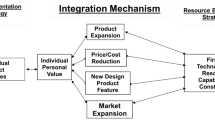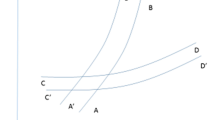Abstract
Supply chain decision-making processes that are not tightly integrated with marketing decisions may well be costing the firm twice. First, this will promote poor operations level decisions and second, this may provide management with a view of their firm that will lead to inappropriate strategic decisions. The motivation of this paper is to explore the relationships between decision-making at various levels within the firm and, in particular, the relationship between the firm’s strategic and operations decision making. Using the case of a manufacturer managing a supply chain we show that increasing revenues may not increase profits and cutting costs may also reduce profits. We also show that the strategic or tactical view of the firm, and consequently the quality of the firm’s strategic and tactical decisions, can be highly dependent on how the firm makes low-level marketing and supply chain decisions. Our results illustrate the significant benefit available to manufacturers who can successfully and tightly integrate production, logistics, and marketing decision making. Such integration will improve operations level decisions and also provide an improved platform for tactical and strategic decisions.

Similar content being viewed by others
Notes
www.prospricing.com accessed March 25, 2008.
Manugistics Inc. “Enterprise Profit Optimization,” White paper 2001 online at: http://www.manugistics.com/documents/epo_whitepaper.pdf.
References
Amaruchkul, K., Cooper, W. L., & Gupta, D. (2007). Single-leg air-cargo revenue management. Transportation Science, 41(4), 457–469.
Baker, T. K., & Collier, D. A. (1999). A comparative revenue analysis of hotel yield management heuristics. Decision Sciences, 30, 239–263.
Ballou, R. H. (1992). Business logistics management (3rd ed.). Englewood Cliffs, NJ: Prentice-Hall.
Beamon, B. M. (1998). Supply chain design and analysis: Models and methods. International Journal of Production Economics, 55(3), 281–294.
Bell, P. C. (1999). Management science/operations research: A strategic perspective. Cincinnati: South-Western Publishing.
Bell, P. C. (2012). The concepts of revenue management: A tutorial. International Transactions in Operational Research, 19(1–2), 23–37.
Bell, P. C., Anderson C. K., & Kaiser S. P. (2001). Is there life after Edelman? Analysis of former finalists reveals OR/MS is alive, well and hard at work long after the award presentations, OR/MS Today, June (pp. 26–31). http://lionhrtpub.com/orms/orms-6-01/bellfr.html.
Bell, P. C., & Chen, J. (2006). Cutting costs or enhancing revenues? An example of a multi-product firm with impatient customers illustrates an important choice facing operational researchers. Journal of the Operational Research Society, 57(4), 443–449.
Bitran, G., & Gilbert, S. M. (1996). Managing hotel reservations with uncertain arrivals. Operations Research, 44(1), 35–49.
Bitran, G., & Mondschein, S. (1995). An application of yield management to the hotel industry considering multiple stays. Operations Research, 43(3), 427–443.
Bixby, A., Downs, B., & Self, M. (2006). A scheduling and capable-to-promise application for swift and company. Interfaces, 36(1), 69–86.
Camm, J. D., Chorman, T. E., Dill, F. A., Evans, J. R., Sweeney, D. J., & Wegryn, G. W. (1997). Blending OR/MS judgment and GIS: Restructuring P&G’s supply chain. Interfaces, 27(1), 128–142.
Chen, J., & Bell, P. C. (2009). The impact of customer returns on pricing and order decisions. European Journal of Operational Research, 195(1), 280–295.
Chen, J., Wang, J., & Bell, P. C. (2014). Lease expiration management for a single lease term in the apartment industry. European Journal of Operational Research, 238(1), 233–244.
Chiu, C., Choi, T. M., & Tang, C. S. (2011). Price, rebate, and returns supply contracts for coordinating supply chains with price-dependent demands. Production and Operations Management, 20(1), 81–91.
Choi, T. M. (2013). Multi-period risk minimization purchasing models for fashion products with interest rate, budget, and profit target considerations. Annals of Operations Research. doi:10.1007/s10479-013-1453-x.
Cross, R. G. (1995). An introduction to revenue management. In D. Jenkins (Ed.), Handbook of airline economics (pp. 443–468). New York, NY: The Aviation Weekly Group of the McGraw-Hill Companies.
Denton, R. T., Forrest, J., & Milne, J. R. (2006). IBM solves mixed-integer program to optimize its semiconductor supply chain. Interfaces, 36(5), 386–399.
Dietrich, B., Donofrio, N., Lin, G., & Snowdon, J. (2000). Big benefits for big blue: A variety of projects demonstrate how operations research delivers business value to IBM. OR/MS Today, June.
Federgruen, A., & Heching, A. (1999). Combined pricing and inventory control under uncertainty. Operations Research, 47(3), 454–475.
Geraghty, M. K., & Johnson, E. (1997). Revenue management saves national car rental. Interfaces, 27(1), 107–127.
Geunes, J., & Pardalos, P. (2006). Supply chain optimization. Berlin: Springer.
Keene, S., Albert, D., Henby, G., Brohinsky, A. J., & Tayur, S. (2006). Caterpillar’s building construction products division improves and stabilizes product availability. Interfaces, 36(4), 283–295.
Leachman, R. C., Kang, J., & Lin, V. (2002). SLIM: Short cycle time and low inventory in manufacturing at samsung electronics. Interfaces, 32(1), 62–77.
Leibs, S. (2000). Aided by new software, the automaker is using revenue management to boost the bottom line. CFO Magazine, August 01. http://www.cfo.com/Article?article=1776.
Muckstadt, J. A., & Roundy, R. O. (1993). Logistics of production and inventory, Vol. 4: Handbooks in operations research and management. Amsterdam: North-Holland.
Northwest Newsprint, Inc. case (A). (1998). 9A98E035, Ivey Publishing.
Northwest Newsprint, Inc. case (B). (2009). 9B09E003, Ivey Publishing.
Pooley, J. (1994). Integrated production and distribution facility planning at Ault foods. Interfaces, 24(4), 113–121.
Smith, B., Leimkuhler, J., Darrow, R., & Samuels, J. (1992). Yield management at American Airlines. Interfaces, 22(1), 8–31.
Talluri, K., & van Ryzin, G. (2004). The theory and practice of revenue management (1st ed.). Boston: Kluwer.
Vollmann, T. E., Berry, W. L., Whybark, D. C., & Jacobs, F. R. (2005). Manufacturing planning and control for supply chain management. The McGraw-Hill/Irwin series in operations and decision sciences. Boston: McGraw-Hill/Irwin.
Thomas, J. W. (2007). Market segmentation. http://www.decisionanalyst.com.
Acknowledgments
The authors gratefully acknowledge financial support from the Natural Sciences and Engineering Research Council of Canada.
Author information
Authors and Affiliations
Corresponding author
Appendix
Appendix
1.1 Proof of result 1
From (2) we construct the Lagrangian:
The first order conditions for a maximum with respect to \(P_{j}\) are:
To find \(\lambda \) we note that \({\sum }_{j=1}^N {(a_j-b_j P_j)}=Q\) hence:
Writing \({\sum }_{j=1}^N {a_j=A}\) and \({\sum }_{j=1}^N {b_j=B}\), then \(A+\lambda B=2Q\hbox { or }\lambda =(2Q-A)/B\), which lead to
Rights and permissions
About this article
Cite this article
Bell, P.C., Chen, J. Close integration of pricing and supply chain decisions has strategic as well as operations level benefits. Ann Oper Res 257, 77–93 (2017). https://doi.org/10.1007/s10479-014-1784-2
Published:
Issue Date:
DOI: https://doi.org/10.1007/s10479-014-1784-2




